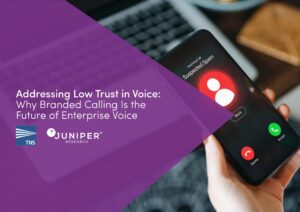The relentless surge of robocalls has inundated Americans to the point of exhaustion. In 2024 alone, Americans received more than 70 billion unwanted calls. This staggering volume has led to fewer Americans answering the phone: according to recent TNS’ independent research, 72% won’t answer calls from unknown numbers.
For contact center and CS/CX professionals, robocalls are proving equally problematic regarding customer engagement, retention and management. Innovative strategies, processes and technologies are required to grow revenue and protect against negative bottom-line impact.
However, bad actors lurk amid those efforts, exploiting vulnerabilities to execute fraudulent schemes, harass consumers and impersonate legitimate enterprises to steal money from unsuspecting Americans.
Telecom providers, industry partners, policymakers and regulators continue to focus on working together to mitigate robocalls and protect Americans from voice call threats. Meanwhile, contact centers face a delicate dilemma: maintaining compliance while fostering consumer engagement and safeguarding customers from the increasing misuse of AI by bad actors.
Outbound Communication Rules and Regulation
The Telephone Consumer Protection Act (TCPA) is the primary regulation restricting telephone solicitations and the use of automated telephone equipment. Enacted in 1991, it shields Americans from unwanted telemarketing calls, faxes and robocalls. The Act also introduced the National Do Not Call Registry, which enables consumers to opt out of problematic robocalls and recurring telemarketing communications.
In December 2023, the Federal Communications Commission (FCC) strengthened this law with new additions, including a rule closing the lead generator loophole. Lead-generated communications often relied on weak claims of consent and accounted for a large percentage of unwanted robocalls and robotexts.
The “one-to-one” consent measure required consumers to give express written consent to each individual seller to receive communications from that entity. The measure would have ended a loophole allowing telemarketers and “lead generators” to sell consumer information to other telemarketers, even when the consumer only meant to consent to being contacted by one telemarketer. Pre-checked boxes on web forms were banned, ensuring consumers only select the companies they wish to hear from.
However, in a major legal development, in February 2025 the US Court of Appeals for the Eleventh Circuit vacated the FCC’s “one-to-one” consent requirement under the TCPA, reopening the floodgates for telemarketing and robocalls. This is the sort of confusion that bad actors thrive in.
With the “one-to-one” consent rule temporarily halted, and the FCC reviewing this new ruling, businesses should continue adhering to prior express written consent requirements until further legal clarity is established. Regardless of the outcome, companies will continue to face headwinds in cutting through the noise with legitimate outbound communications.
Beyond federal laws, some enterprises are also forced to navigate varying state-level regulations, which impose stricter limitations on outbound calling. Florida restricts telemarketing calls to between 8:00 AM and 8:00 PM, a narrower window than the federal 8:00 AM to 9:00 PM allowance.
Last year, Washington introduced the “Robocall Scam Protection Act”, aligning state regulations with federal do-not-call rules while expanding protections against unauthorized automated solicitations.
Starting this year, New York will require telemarketers to identify themselves within the first 30 seconds to combat scams.
Finally, on the heels of a deepfake political robocall featuring a cloned voice of President Biden urging New Hampshire voters to stay home during the 2024 primaries, the FCC moved aggressively with AI calling regulations. Regulators banned AI-generated voices in robocall scams to protect voters, consumers and businesses from AI-driven fraud.
As enterprises comply with these strict rules and regulations, contact center professionals must rethink their outbound communication strategies to enhance engagement and maintain compliance.
Creating a Holistic Voice Channel Strategy
According to a TNS survey of contact center decision-makers, 89% reported issues with fraudsters spoofing their business’s identity. Despite widespread concern over spam and fraud, 31% of respondents indicated their company is not using tools to prevent spoofing.
This gap exists partly because contact centers have historically focused more on inbound communications than outbound calling. However, with 94% of call center managers and executives deeply concerned about the impact of spam and fraud on outbound calling, the pressure to secure voice communications is rising.
Enterprises must prioritize security and transparency to rebuild consumer trust in the voice channel. Once trust is restored, stronger customer engagement, higher answer rates and revenue growth will follow.
The key to securing the voice channel lies in adopting critical outbound calling technologies:
- Branded Calling. Displays critical call information on incoming call screens, such as the brand name and logo, so recipients can identify the caller and feel confident answering. By branding calls, contact center operators and their parent organizations reestablish trust with recipients, prompting customers to recognize the origin of the call and feel confident answering.
- Call Authentication. Verifies each outgoing call from an authorized number, eliminating consumer uncertainty and reducing fraudulent robocalls.
- Spoof Protection. Unauthorized calls are blocked before they reach customers, preventing fraudsters from making contact.
- Call Analytics. AI-driven analytics and machine learning generate call reputation profiles to distinguish legitimate calls from fraudulent ones.
By understanding consumer concerns and adopting these technologies, enterprises can proactively protect their customers and improve engagement.
High-Touch Verticals At High Risk
Financial institutions, for example, have been particularly vulnerable to fraudsters using the voice channel to launch nefarious campaigns. Even the largest national banks have been targeted by bad actors weaponizing AI.
In one high-profile example, a Chase Bank customer lost over $120,000 from his checking account. He received a call from an 800 number that matched Chase’s customer service, asking him to verify a suspicious transaction. From there, he was prompted to log in to his account through a secured link sent via text message. The bad actors captured his login information and stole his money.
Common financial scams include fraudulent calls regarding tax season, ghost filers, unpaid tolls and student loan payments. Americans should not be solely responsible for differentiating between legitimate and fraudulent calls made by robocall scammers.
With the proper, secure communications strategy, financial enterprises can combat robocall bad actors and successfully protect their customers from these attacks.
In 2024, a major national bank faced a large-scale phishing attack. Customers received a text warning them about fraudulent activities on their accounts and were notified that they would receive a phone call from the bank that appeared to be legitimate but was, in fact, scammers.
In response, the bank deployed branded calling, call authentication, spoof protection and call analytics. Within the first five months of these solutions, 941,000 total calls had been received, and nearly 14% of calls were marked as potential spam and blocked. In addition to protecting customers, these solutions also improved customer engagement: by month three, the bank’s call durations had increased by 13%.
Balancing Compliance and Engagement
Contact centers and their parent organizations must continuously adapt to evolving outbound communication regulations. To maintain compliance without sacrificing critical consumer engagement, enterprises should adopt a proactive, holistic approach that integrates advanced authentication methods, branded calling, AI-driven analytics and fraud prevention measures.
By anticipating regulatory changes and leveraging innovative solutions, enterprises can protect their customers, maintain trust and enhance the efficiency of their outreach strategies.
Jim Tyrrell is Vice President of Global Product Strategy at TNS with specific responsibility for TNS’ Communications Market.
Use Cases: TNS Enterprise Branded Calling
Browse our use case library to see how TNS is helping enterprises to improve engagement with their customers, increase call answer rates and achieve better business outcomes.




